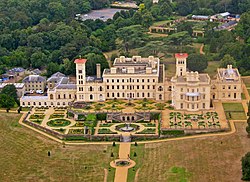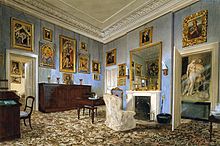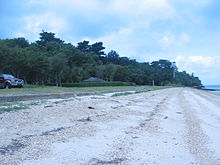Osborne House
| Osborne House | |
|---|---|
 Aerial view of Osborne House | |
| General information | |
| Architectural style | Italian Renaissance |
| Location | Isle of Wight |
| Town or city | East Cowes |
| Country | United Kingdom |
| Coordinates | 50°45′02″N 01°16′11″W / 50.75056°N 1.26972°W |
| Construction started | 1845 |
| Completed | 1851 |
| Design and construction | |
| Architect(s) | Prince Albert (designer) |
| Engineer | Thomas Cubitt (builder) |
Osborne House is a former royal residence in East Cowes, Isle of Wight, United Kingdom. The house was built between 1845 and 1851 for Queen Victoria and Prince Albert as a summer home and rural retreat. Albert designed the house in the style of an Italian Renaissance palazzo. The builder was Thomas Cubitt, the London architect and builder whose company built the main facade of Buckingham Palace for the royal couple in 1847. An earlier smaller house on the Osborne site was demolished to make way for the new and far larger house, though the original entrance portico survives as the main gateway to the walled garden.
Queen Victoria died at Osborne House on 22 January 1901, aged 81. Following her death, King Edward VII, who had never liked Osborne, presented the house to the state on the day of his coronation, with the royal pavilion being retained as a private museum to Victoria. From 1903 to 1921, part of the estate around the stables was used as a junior officer training college for the Royal Navy, known as the Royal Naval College, Osborne. Another section of the house was used as a convalescent home for officers. In 1933, many of the temporary buildings at Osborne were demolished. In 1954, Queen Elizabeth II gave permission for the first floor rooms (the private apartments) in the royal pavilion to be opened to the public. In 1986, English Heritage assumed management of Osborne House. In 1989, the second floor of the house was also opened to the public.
The house is listed Grade I on the National Heritage List for England, and the landscaped park and gardens are listed Grade II* on the Register of Historic Parks and Gardens.
History
[edit]Royal retreat
[edit]Queen Victoria and Prince Albert bought Osborne House on the Isle of Wight from Lady Isabella Blachford in October 1845. They wanted a home removed from the stresses of court life. Victoria had spent two holidays on the Isle of Wight as a young girl, when her mother, the Duchess of Kent, rented Norris Castle, the estate adjacent to Osborne. The setting of the three-storey Georgian house appealed to Victoria and Albert, in particular, the views of the Solent reminding Albert of the Bay of Naples in Italy. They soon realised that the house was too small for their needs and decided to replace the house with a new, larger residence.[1]

The new Osborne House was built between 1845 and 1851 in the Italian Renaissance style, complete with two belvedere towers. Prince Albert designed the house himself in conjunction with Thomas Cubitt, the London architect and builder, whose company also built the main façade of Buckingham Palace.[1] The couple paid for much of the furnishing of the new house from the sale of the Royal Pavilion at Brighton.[2] The Prince Consort participated directly in laying out the estate, gardens and woodlands, to prove his knowledge of forestry and landscaping. At the more official royal residences, he had been overruled by the Commissioners of Woods and Forests, who had official responsibilities for the grounds.[3] Below the gardens on Osborne Bay was a private beach, where the Queen kept her own private bathing machine. According to a news report: "The queen's bathing machine was unusually ornate, with a front veranda and curtains which would conceal her until she had entered the water. The interior had a changing room and a plumbed-in WC."[4]

The original square wing of the house was known as "The Pavilion", containing the principal and royal apartments on the ground and first floors, respectively. The principal apartments, particularly, hold reminders of Victoria's dynastic links with the other European royal families. The Billiard Room holds a massive porcelain vase that was a gift of the Russian Tsar. The Billiard Room, Queen's Dining Room, and the Drawing Room on the ground floor all express grandeur.

In marked contrast is the more homely and unassuming décor of the royal apartments on the first floor. They include the Prince's Dressing Room, the Queen's Sitting Room, the Queen's Bedroom, and the children's nurseries. Intended for private, domestic use, the rooms were made as comfortable as possible. Both Queen Victoria and Prince Albert were determined to bring up their children in a natural and loving environment. They allowed the royal children to visit their parents' bedrooms frequently, at a time when children of aristocrats often lived removed from their parents in nurseries, only joining them occasionally in public rooms, rather than in shared intimate spaces.[5]


The main wing was added later. It contains the household accommodation and council and audience chambers, as well as a suite for Victoria's mother. The final addition to the house was a wing, built between 1890 and 1891, designed by John Lockwood Kipling, father of the poet Rudyard Kipling. The ground floor includes the famous Durbar Room, named after an Anglicised version of the Hindi word durbar, meaning court. The Durbar Room was built for state functions. It was decorated by Bhai Ram Singh in an elaborate and intricate style, and has a carpet from Agra. It now holds gifts Queen Victoria received on her Golden and Diamond jubilees. They include engraved silver and copper vases, Indian armour, and a model of an Indian palace.[6] The first floor of the new wing was for the sole use of Princess Beatrice and her family. Beatrice was the Queen's youngest daughter, and she lived near Victoria during her life.
Osborne House expresses numerous associations with the British Raj and India, housing a collection of paintings of Indian persons and scenes, painted at Queen Victoria's request by Rudolf Swoboda. These include depictions of Indians resident or visiting Britain in the 19th century, and scenes painted in India when Swoboda travelled there to create such works.[7]
The royal family stayed at Osborne for lengthy periods each year: in the spring for Victoria's birthday in May; in July and August when they celebrated Albert's birthday; and just before Christmas.[1] In a break from the past, Queen Victoria and Prince Albert allowed photographers and painters to make works featuring their family in the grounds and in the house. That was partly for their own enjoyment and partly as a form of public relations, to demonstrate to the nation their character as a happy and devoted family. Many thousands of prints of the royal family were sold to the public, which led Victoria to remark, "no Sovereign was ever more loved than I am (I am bold enough to say)."[8] Writing to her daughter Princess Victoria in 1858 about the gloominess of Windsor Castle, Queen Victoria stated, "I long for our cheerful and unpalacelike rooms at Osborne."[9]

The grounds also included a "Swiss Cottage" for the royal children. The cottage was dismantled and brought piece by piece from Switzerland to Osborne where it was reassembled.[3] There, the royal children were encouraged to garden. Each child was given a rectangular plot in which to grow fruit, vegetables and flowers. They sold their produce to their father. Prince Albert used this as a way to teach the basics of economics. The children also learned to cook in the Swiss Cottage, which was equipped with a fully functioning kitchen. Both parents saw this kind of education as a way of grounding their children in the activities of daily life shared by the people in the kingdom despite their royal status.[1]
In 1859, Prince Albert designed a new and larger quadrangular stable block, which was built by Cubitts on the former cricket pitch. The building is listed Grade II* on the National Heritage List for England.[10] After Prince Albert died at Windsor Castle in December 1861, Queen Victoria continued to visit Osborne House because it was one of her favourite homes. In 1876, as a tribute to Queen Victoria, the Government House in the colony (now State) of Victoria, Australia, was constructed as a copy of Osborne House.
On 14 January 1878, Alexander Graham Bell demonstrated an early version of the telephone to the queen at Osborne House,[11] placing calls to Cowes, Southampton and London. They were the first publicly witnessed long-distance telephone calls in Britain. The queen tried the device and considered the process to be "quite extraordinary" although the sound was "rather faint".[12] She later asked to buy the equipment that was used, but Bell offered to make "a set of telephones" specifically for her.[13][14]
National gift
[edit]
Queen Victoria died at Osborne on 22 January 1901, with two generations of her family present. Although she adored Osborne, and her will left strict instructions that Osborne was to remain in the family, her children did not share the attachment. Princess Beatrice and Princess Louise were granted houses on the estate. Edward VII presented Osborne to the nation on his Coronation Day in August 1902.[15] The royal apartments on the upper floors of the pavilion wing, including the late Queen's bedroom, were turned into a private museum accessible only to the royal family.
Later uses
[edit]Royal Naval College, 1903–1921
[edit]In 1903, the new stable block became a junior officer training college for the Royal Navy known as the Royal Naval College, Osborne.[15] Initial training began at about the age of 13, and after two years studies were continued at the Royal Naval College, Dartmouth. The college closed in 1921, with the last students leaving on 9 April 1921.[16] Former students of Osborne included Queen Victoria's great-grandsons, the future Edward VIII and George VI, and their younger brother George, Duke of Kent. Another well-known alumnus of the college was Jack Llewelyn Davies, one of the five Llewelyn Davies boys who inspired J. M. Barrie's Peter Pan. The case of George Archer-Shee from 1908, who was expelled from Osborne after being falsely accused of stealing a 5-shilling postal order, inspired the play The Winslow Boy.
Military convalescent home
[edit]During World War I, the secondary wings of Osborne House were used as an officers' convalescent home. Robert Graves and A. A. Milne were two famous patients. Known as the King Edward VII Retirement Home for Officers, it later accommodated convalescents from military and civil service backgrounds, including retired officers of the British armed services until 2000.[15]
Thomas Cubitt
[edit]Thomas Cubitt was one of the most renowned architects of the 19th century, known as "the Emperor of the building trade".[17]
Prince Albert, impressed with his previous works, commissioned him to rebuild Osborne House.[18] Cubitt and Prince Albert worked hand in hand in constructing and designing the house, creating the mix of Palladian architecture and Italian renaissance style. Cubitt not only designed the structure but also implemented many of his own features into the house from his own workshops. As well as the doors and fireplaces of his own design, he also incorporated his own patterns for the plaster within the house.[19]
The design of Osborne House is stately and intended for royalty, but it is not so grand that it is unwelcoming. Queen Victoria and Prince Albert wanted an escape from the stuffiness of Buckingham Palace; they wanted a home for their children to feel free and welcome. Once Osborne House was complete, they commissioned Cubitt to build the east wing of Buckingham Palace. Victoria admired Cubitt not only for his work on Osborne House but also for his character. She referred to him as "our Cubitt" and on his death said that "a better, kinder-hearted man never breathed".[17]
Preservation
[edit]
Since 1986, Osborne House has been under the care of English Heritage. It is open to the public. The house is listed Grade I on the National Heritage List for England, and the landscaped park and gardens are listed Grade II* on the Register of Historic Parks and Gardens.[20][21]
The former Naval College's cricket pavilion was converted into a holiday cottage in 2004. Since 2005, the house has occasionally hosted picnic-style concerts on the lawn outside the main house.[22][23]
Queen Victoria's private beach at Osborne, including her personal bathing machine, was opened to the public for the first time in July 2012, following an extensive restoration programme.[24][25]
References
[edit]- ^ a b c d Struthers, p. 36.
- ^ The Royal Palaces of Britain by John Adair, p. 31.
- ^ a b Williams, p. 116.
- ^ "Victoria's plunge: Queen's beach to open to public". The Independent. 17 July 2012. Retrieved 23 June 2023.
- ^ Royal Palaces of Britain, p. 38.
- ^ Royal Palaces of Britain, p. 39.
- ^ "Calendars and diaries". National Gallery. Retrieved 17 August 2014.
- ^ Royal Palaces of Britain, p. 37.
- ^ The Royal Palaces of Britain, p. 36.
- ^ Historic England. "Former Stables at Osborne House (1255100)". National Heritage List for England. Retrieved 12 September 2022.
- ^ "140 Years Since First Telephone Call to Queen Victoria on the Isle of Wight". Island Echo. 14 January 2018. Retrieved 14 January 2020.
He made the UK's first publicly-witnessed long distance calls, calling Cowes, Southampton and London. Queen Victoria liked the telephone so much she wanted to buy it.
- ^ "Alexander Graham Bell demonstrates the newly invented telephone". The Telegraph. 13 January 2017. Archived from the original on 12 January 2022. Retrieved 14 January 2020.
one of the Queen's staff wrote to Professor Bell to inform him 'how much gratified and surprised the Queen was at the exhibition of the Telephone'
. - ^ "pdf, Letter from Alexander Graham Bell to Sir Thomas Biddulph, February 1, 1878". Library of Congress. Retrieved 14 January 2020.
The instruments at present in Osborne are merely those supplied for ordinary commercial purposes, and it will afford me much pleasure to be permitted to offer to the Queen a set of Telephones to be made expressly for her Majesty's use.
- ^ Ross, Stewart (2001). Alexander Graham Bell. (Scientists who Made History). New York: Raintree Steck-Vaughn. pp. 21–22. ISBN 978-0-7398-4415-1.
- ^ a b c Struthers, p. 39.
- ^ The Times, 2 February 1921.
- ^ a b Hargreaves, A (2002). "Cubitt, Thomas (1788–1855)". Oxford Dictionary of National Biography (online ed.). Oxford University Press. doi:10.1093/ref:odnb/6859. (Subscription or UK public library membership required.)
- ^ "Ranmore War Memorial Discovering the men of the parish who died in the two World Wars". Ranmore War Memorial. 31 May 2014. Retrieved 2 December 2019.
- ^ Banerjee, Jacquline. "Osborne, Isle of Wight, by Thomas Cubitt with Prince Albert: The Pavilion". Victorian Web. Retrieved 2 December 2019.
- ^ Historic England. "Osbourne House (1223802)". National Heritage List for England. Retrieved 12 September 2022.
- ^ Historic England. "Osborne (1000929)". National Heritage List for England. Retrieved 12 September 2022.
- ^ "Big name gigs for Osborne". Isle of Wight County Press. 4 December 2001. Retrieved 16 June 2009.
- ^ "Top acts to play historic house". Isle of Wight County Press. 7 August 2001. Retrieved 5 July 2009.
- ^ English Heritage. "Queen Victoria's private beach to open". Retrieved 27 July 2012.
- ^ Nigel Richardson. "Queen Victoria's private beach to open to the public". Archived from the original on 12 January 2022. Retrieved 27 July 2012.
Sources
[edit]- Adair, J.E. (1981). The Royal Palaces of Britain. C.N. Potter. ISBN 978-0-517-54554-6.
- Struthers, J.; Coe, C.; Riddle, P. (2004). Royal Palaces of Britain. New Holland. ISBN 978-1-84330-733-4.
- Turner, Michael (2007). Osborne. London: English Heritage. ISBN 978-1-84802-295-9.
Further reading
[edit]- Ames, Winslow (1968). Prince Albert and Victorian Taste. London: Chapman and Hall.
- Florance, Arnold (1987). Queen Victoria at Osborne. English Heritage. ISBN 1-85074-154-9. 2nd edition.
- Hobhouse, Hermione (1983). Prince Albert: His Life and Work. London: Hamish Hamilton. ISBN 978-0-241-11142-0.
- Matson, J.A. (1978). Dear Osborne: Queen Victoria's Family Life in the Isle of Wight. Hamish Hamilton. ISBN 978-0-241-89870-3.
- Sarah, Duchess of York (1991). Victoria and Albert: Life at Osborne House London: Weidenfeld & Nicolson. ISBN 978-0-297-83107-5
External links
[edit]- 1851 establishments in England
- Houses completed in 1851
- Country houses on the Isle of Wight
- East Cowes
- English Heritage sites in the Isle of Wight
- Gardens on the Isle of Wight
- Grade I listed buildings on the Isle of Wight
- Grade I listed houses
- Grade II* listed parks and gardens
- Historic house museums on the Isle of Wight
- Italianate architecture in England
- Royal residences in England
- Queen Victoria
- Prince Albert of Saxe-Coburg and Gotha

